Corner sinks in the bathroom: general overview + installation instructions
The choice to favor sanitary equipment of an unusual configuration is prompted by the desire to make limited space as convenient as possible. This problem is also solved by the corner sink in the bathroom, the installation of which allows you to use the previously empty area.
Such products are convenient, functional, have an extraordinary design. But for trouble-free operation, it is important to install plumbing correctly. And we will talk about this in our article. We also consider the main differences between different types of sinks of an angular type, their features and characteristics that affect the complexity of the installation. And here is a list of the best manufacturers of such plumbing.
For a better understanding of the installation process, the material is equipped with videos with installation instructions and analysis of the most popular errors.
The content of the article:
Types of corner sinks
Angular sinks are sometimes the only option for the rational arrangement of plumbing fixtures and furniture in a small bathroom. These products are classified by installation method, shape, material.
Corner installation method
These corner sinks, depending on the installation order, are produced in different versions:
- in the shape of a tulip;
- hanging;
- built-in;
The first model is produced complete with a leg 0.7 - 0.8 m high, which is enough for the average user. More on sink height we wrote here.
The leg of a tulip is very useful: on the one hand, it masks the piping and siphon, on the other - the remaining space under the sink cannot be used completely. But such sinks are produced in rich colors and, as a rule, are beautifully decorated.
A hanging sink reveals the prospects for a more rational use of space. It may be enough to place some objects under it and even a washing machine.To fit this unit, you need a corner sink with a flat bottom and a special design siphon. This option is perfectly compatible with the top of the washing machine.

Hanging shells or consoles are attached, as they are also called, to the wall on special brackets. The mixer is mounted on the sink or wall. Their height can be changed based on your own needs.
Finds its supporters and such a modern solution as installation of a laid on sink on a hanging countertop.
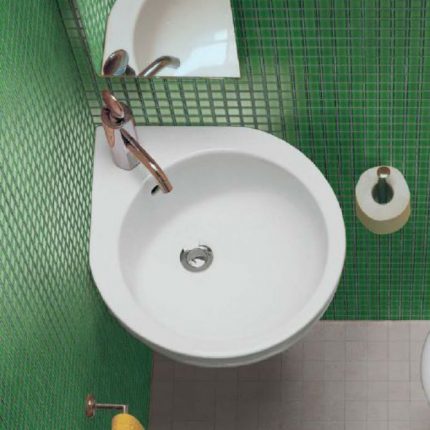
The built-in corner sink may seem bulky. Under it, you really need more space than under the first two types. But the curbstone in which it is built in will hide sewer communications and serve as a repository for many things that are necessary in the bathroom.
In addition to the curbstone, a hanging countertop can serve as a place for installing a hanging sink.

Usually a sink and a cupboard for it are sold in the kit. Models have different dimensions. The sides of the cabinet in contact with the walls have a length of 35 to 70 cm.
Manufacturers produce similar models in two versions - right and left-handed. In the first version, the sink is placed on the left, in the left-side - on the contrary.
Plumbing Classification
By their constructive solution, there are angular shells both of a traditional triangular shape, and asymmetric, elongated.
The shape of the triangle saves the maximum area. Such a sink can be built into the smallest bathrooms. More ideas for sinks for a small bathroom we reviewed in our other article.
If there is no space at all, a triangular hanging model can be placed above the bathroom.
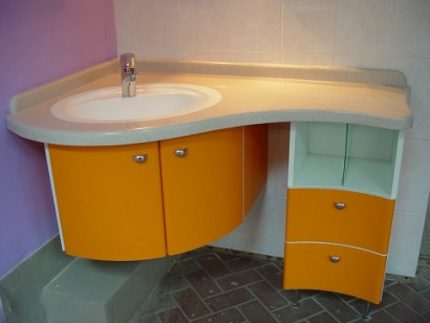
Models in which one side is significantly longer than the second fit well into an elongated bathroom. Their application gives wide prospects for the design of compact bathrooms.
Types of sinks depending on the material
Corner sinks are made both from materials that have long become traditional, as well as from unusual ones that have been used recently. Each has its advantages and not entirely positive aspects. Old materials include ceramics, metal. A new trend is the use of glass, artificial stone, wood for the production of shells.
Faience (ceramics) is most common in bathrooms. It is durable, hygienic, smooth and pleasant to touch. The color is most often white, but different colors are possible. Strength characteristics are high, and care is simple.
The lack of faience is porosity, its longevity depends on the quality of the glaze applied to the surface. This type of ceramic, like porcelain, is more beautiful, but more fragile. The earthenware sink, decorated with a branch pattern on the entire surface or only around the perimeter, looks natural in the bathroom, decorated in the Provence, country styles.
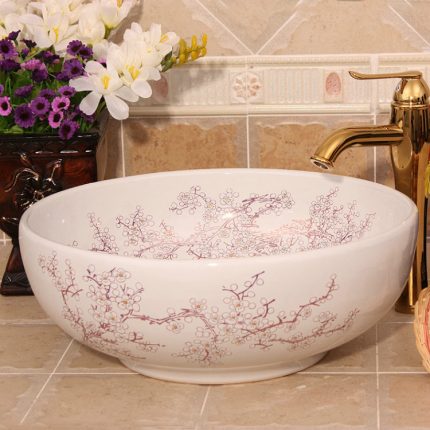
The cost of porcelain models are little different, unless it is hand-painted. High-quality clay is used for their production; subsequent high-temperature annealing makes the material very dense. There are no roughnesses on the surface of such a sink; it can be cleaned with any household cleaning products.
The advantage of ceramics is also that the water stream, in contact with it, does not emit loud sounds.
Metal sinks are most often found in the kitchen, but if the bathroom is decorated in a minimalist style, then the metal in it will look organic. Manufacturers color their products with colored glaze, apply relief patterns, and trim that mimics precious metals. The surface is both glossy and matte.

Shells are made from metals such as stainless steel, brass, copper, nickel, bronze. When installing metal alloy plumbing in a bathroom, it is necessary to select the appropriate accessories.
A plumbing product that brings lightness and spaciousness to the interior of the most cramped bathroom is glass sink. For the manufacture of glass sinks, their creators use tempered glass, a certain thickness - 15 mm or more. Color, shape of products are diverse.
In terms of strength, these glass products are comparable to porcelain tiles. They well perceive cleaning with aggressive chemistry, a sharp change in water temperatures. But hard brushes and abrasive products should not be used.
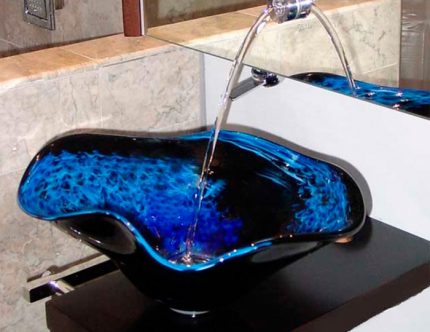
Practicality, these beautiful, elegant products do not differ. To make them look tidy, daily care is needed. The main enemy - stains, drips, clearly visible to the naked eye. After each washing, you need to wipe it dry, otherwise the drops of water will dry out and leave an ugly mark.
The corner sink intended for a bathtub from a natural stone is superresistant to cracking and delamination. Granite or marble is commonly used. These products look solid, always exclusive, because two identical stones do not exist in nature. They create an aura of reliability, special coziness, comfort.
The stone has a high resistance to mechanical damage, a fungus will not appear on its surface. Appearing scratches are easily removed by grinding. Their cost is quite high.
Deciding to invest in stone sink, you should know that she is afraid of acid and alkali substances. If serious damage occurs, the sink cannot be restored.
Visually, only an experienced specialist can distinguish natural from artificial stone. The surface of the composite shell is just as hard, it resists mechanical stresses well, but artificial material resists shocks better. His price is much lower.
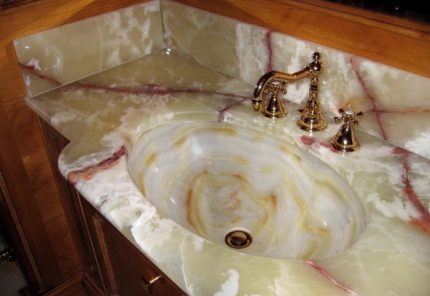
Among the shortcomings of acrylic stone, it should be noted that its service life is shorter than that of a natural material due to the presence of seams. Do not allow agents to clean drains on the surface of sinks made of artificial stone.
Non-traditional material, adapted to obtain sinks in the bathroom, is micro-concrete. The material is completely safe due to its environmental friendliness. It is easy to maintain, resistant to mechanical stress, but temperature spikes are dangerous for it. Basically, for such sinks you need to make an individual order.
Micro-concrete, no matter how high-quality it may be, is hygroscopic, so it gets darker over time. There are no seams at such a sink, and this indicates that dirt on its surface will not accumulate.
The elite category includes wood sinks. They are made of wood of durable moisture-resistant species: teak, hornbeam, larch, oak, cedar, and others. There are models from bamboo. Such products are polished, several times covered with stain, varnish, so they are reliably protected from mold.The shape at the sink can be any.
Care for these noble products needs special. Cleaning products - only soft, no scratching, sharp objects. It is required for a wooden sink and periodic restoration - every 3-4 years. So to the considerable cost of the sink itself, the price of this service should also be added.
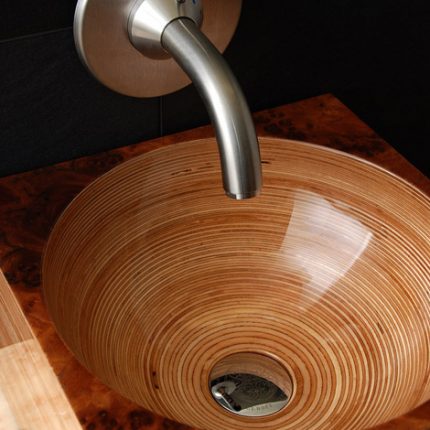
Wooden shells adorn with painting, carving, polish the surface to a mirror shine, but the best decoration is a drawing created by nature. The value of the wood species affects the price of products, but they are never cheap. They are not made on the conveyor, neither the model is almost exclusive.
Mounting a corner sink
For a cramped area, plumbing is chosen based on its ergonomics. Installation technology depends on the type of angular model and is almost the same as for conventional analogues. They are fastened most often with brackets, but they also use anchors, studs, dowels.
Before buying, you need to take measurements of the room and calculate sink size taking into account the entry and exit of sewer and water pipelines.
Instruction # 1 - installation of a hanging sink
Corner Washbasins fasten to the wallsforming an angle using consoles. This installation method creates a rigid, reliable mount.
Experts advise you to follow two rules:
- The best installation location is in the area where the sewer and water pipes are located.
- The optimal height from the floor is within 0.9 - 0.98 m.
Light hanging shells are mounted on screws and dowels. For stone products, this installation method is not suitable, due to their heavy weight. A more reliable support is needed here, so the sink is fixed using special brackets. The walls to which the corner piece is attached must be strong, plasterboard partitions will not work for this purpose.
In the area where the sink will come into contact with the wall, draw a horizontal line to the floor with the help of a level. Mark on the surface of the place for mounting studs, then drill holes, screw dowels into them, screw the studs to a certain depth.
Outside, a pin should remain with a length equal to the width of the sink plus 1.5 cm, otherwise there will be nowhere to tighten the nuts at the end of installation.
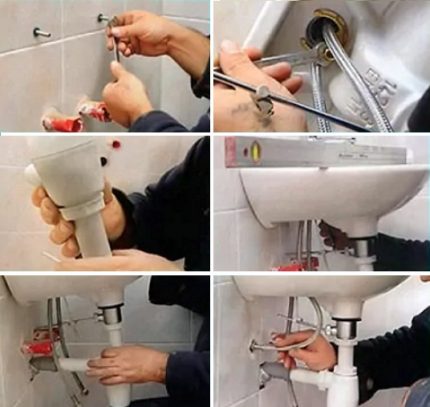
Before fixing the sink, the mixer is mounted on it, having previously screwed flexible hoses and studs into it. A water supply hose is pulled into the hole, putting a seal on it. After the seal, put on the washer, tighten the nuts on all hoses.
The threaded part of the angle valves is covered with sealant, wrapped with hemp and twisted. Putty is applied to the back of the sink. The sink is hoisted on hairpins. They put on seals made of plastic or elastic rubber, washers, then screw nuts.
So that the forces evenly act on the sink, the nuts are tightened alternately. After the final fixation of the sink, it is connected to the water supply and sewage. Flexible eyeliner is connected on one side to the water pipe, and the other to the mixer through the corresponding nozzles.
The drain sewer can pass in the wall or under the floor. It is necessary to find the outlet in it and screw in the siphon receiving pipe into it. So that the joint does not let any aromas into the room, it should be sealed with a rubber ring.
Attach to the issue and overflow pipewhen an overflow hole is present in the sink.
Instruction # 2 - installation of the built-in corner sink
When purchasing a sink with a nightstand, the latter should have an opening in which all pipes and a siphon will comfortably fit. Doors in a curbstone should open freely and not to cling to the equipment or furniture standing nearby. The curbstone is installed first, followed by a sink, then pipes and a siphon.
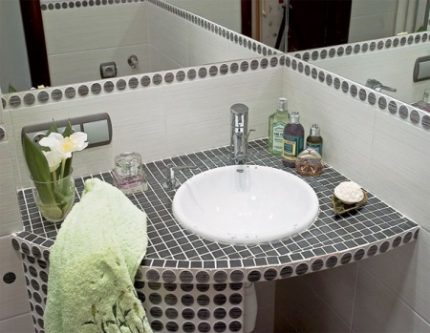
Placing a nightstand in the corner, adjust the legs, try on the sink. Next, mark the place of fasteners, make holes in the wall. After that, the nightstand is fixed and mounted everything else.
Instruction # 3 - installing the sink on a pedestal
The sink should fit tightly into its intended place. When installing plumbing fixtures of the “tulip” type, an important role is given to the correct layout. The lines must be applied very accurately, controlling the process with a hydraulic level. They attach it in the same way as the suspension, but it has additional support.
The technology is simple:
- Mark up and prepare places for pipes. Attach shut-off valves.
- Place a leg in a corner, set up a sink on it. Sliding the structure tightly against the wall, draw a horizontal line, mark the locations of the fasteners.
- Holes under the dowels are made in the walls. Having installed the latter, screw the studs into them.
- Put the washbasin on the studs, tighten the nuts through the gaskets.
- The corrugated hose is inserted into the drain hole, and the siphon is screwed on.
- Connecting the flexible hoses to the mixer, insert the latter into the designated place on the sink. Next, the hoses for heated and cold water are joined with the corresponding outlets, the sanitary valves are connected.
At the end, under the sink, palm off a leg. Then everything is aligned, checked horizontality and fix the structure by tightening the nuts under the sink.
We gave step-by-step instruction on installing the tulip sink in this article.
Top corner sink manufacturers
The range of corner sinks in the market is huge, which complicates the choice. In order not to purchase a product with marriage, you should focus on well-known manufacturers.
Among domestic companies, the following brands stand out:
- Aquaton;
- Astra-form;
- Keramin;
- 1MarKa.
They produce models from all kinds of materials, but most of them come from ceramics.
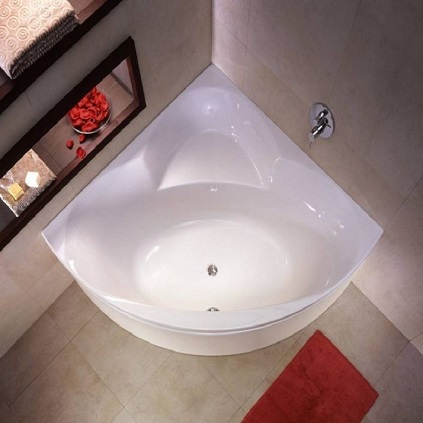
Imported products are represented by such brands as SVEDBERGS, GUSTAVSBERG (Sweden), CEZARES, GLOBO (Italy), Keramag, Kohler, Villeroy & boch (Germany).
Brands are popular JIKA RAVAK (Czech Republic), Sanindusa (Portugal), Delafon (France), Roca (Spain), Kolo (Poland).
Conclusions and useful video on the topic
The video shows the installation process of the built-in washbasin conventional, but using the same technology, the installation of the angular model is also performed:
Errors made during the installation of sinks and their elimination:
Even a very small bathroom can look stylish. A beautiful corner sink in the interior changes and unites the space. The main thing, when choosing it, is to preserve the integral style of the room.
Installation is not very difficult, but all recommendations must be followed in the sequence.
Do you want to share a photo of a beautiful corner sink in your bathroom or something to advise newcomers in questions of installation? Or would you like to supplement our material with valuable comments and clarifications? Please write your recommendations in the block under the article - we will be glad to hear your opinion.

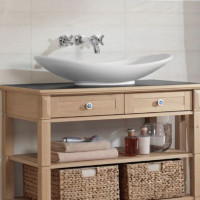 Sink in the bathroom: types of washbasins + nuances of choosing the best design
Sink in the bathroom: types of washbasins + nuances of choosing the best design 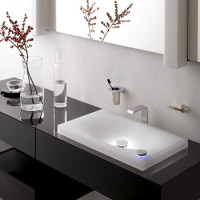 Overhead sink on the countertop in the bathroom: how to choose + installation manual
Overhead sink on the countertop in the bathroom: how to choose + installation manual  Double sink in the bathroom: an overview of popular solutions and mounting nuances
Double sink in the bathroom: an overview of popular solutions and mounting nuances 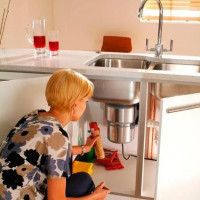 Waste shredder for sink: review of popular models + installation instructions
Waste shredder for sink: review of popular models + installation instructions 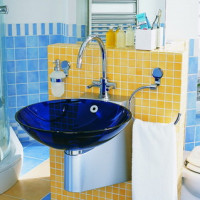 Glass bathroom sinks: types, pros and cons, an overview of the best manufacturers
Glass bathroom sinks: types, pros and cons, an overview of the best manufacturers  How to collect a sink drain: instructions for installing a drain with overflow
How to collect a sink drain: instructions for installing a drain with overflow  How much does it cost to connect gas to a private house: the price of organizing gas supply
How much does it cost to connect gas to a private house: the price of organizing gas supply  The best washing machines with dryer: model rating and customer tips
The best washing machines with dryer: model rating and customer tips  What is the color temperature of light and the nuances of choosing the temperature of the lamps to suit your needs
What is the color temperature of light and the nuances of choosing the temperature of the lamps to suit your needs  Replacement of a geyser in an apartment: replacement paperwork + basic norms and requirements
Replacement of a geyser in an apartment: replacement paperwork + basic norms and requirements
We have a very small bathroom. There’s nowhere to attach a sink. I had to wash my face over the bath. But here she found a way out of the situation. A corner sink is an excellent solution in our particular case. Still, if you put two mirrors on both walls from the corner, it will be convenient, and the room will seem larger. Everything, “went” to the online store to look for a corner sink.
And it seems that we didn’t have a small bathroom, but as we bought a washing machine, there was no place to put it. They rushed with her, rushed about, and in the kitchen she, too, did not find a worthy place. And then they found a way out. Replaced the sink with a corner, and in its place put a washer. Her husband, of course, had to tinker with the conversion, but now everything has a place. It turned out even more convenient than before.